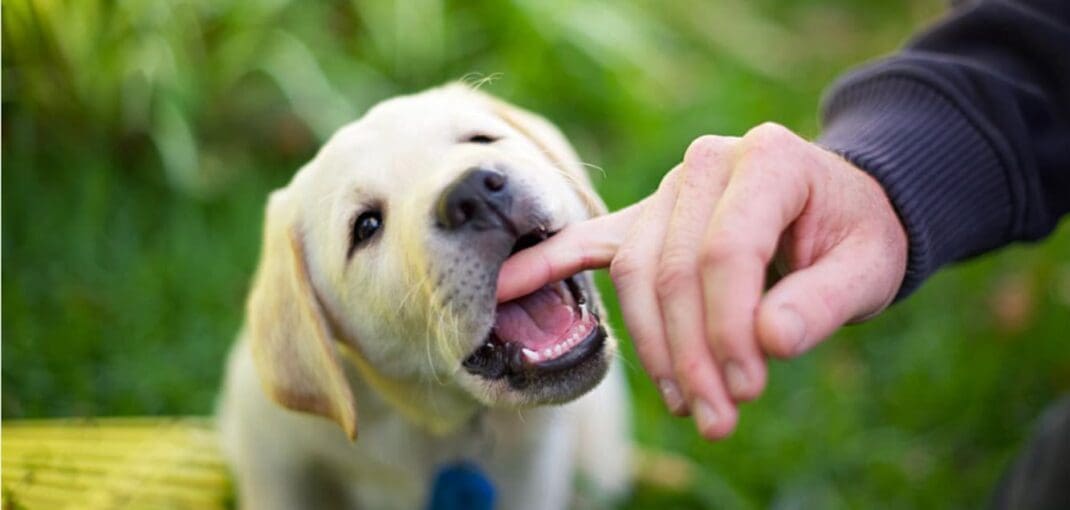Dogs – just like people – can vary in character and temperament Some are very energetic, others are calm by nature. Much depends on the specific breed, but also on the upbringing of the dog, the environment and the experiences of the four-legged dog. It can happen that an initially extremely sweet dog begins to exhibit undesirable behaviour over time. The puppy may bite and growl, which frightens the family. How should it be dealt with?
An aggressive puppy, as reported by pet guardians, is not at all uncommon. Initially, almost every little dog looks like a cute, fluffy ball. However, as it starts to grow up, its behaviour can also change. Aggression in a puppy is not natural, but can become apparent and even perpetuate itself through inappropriate handling of the pet.
What can be done to prevent the dog from being aggressive?
First of all, it is important to realise that every dog can be a little different – calm, lively, boisterous or fearful. Also, everyone (whether purebred or mixed breed) can be polite or aggressive. In doing so, it is important to bear in mind that some breeds may predispose quadrupeds to exhibit a particular behaviour. A good example of this is the amstaff, a breed that is by nature highly intelligent, loyal and attached to its handler. However, its history is marked by aggression, which is why many people see it through the prism of stories about how dangerous these quadrupeds can be. Meanwhile, an aggressive adult dog is more the result of an amstaff puppy that may have been treated inappropriately in the past. Therefore, knowing that certain dogs may exhibit certain traits or require more attention from the guardian in the rearing process, it is a good idea to find out more about the needs and character of a particular breed when choosing a puppy.
An aggressive puppy – how to deal with it?
Aggressive behaviour in a puppy that pulls at the leg or bites the hands of family members is usually a consequence of a number of different factors, e.g.: a tendency to aggression in the parents of the puppy, lack of proper care in the kennel, as well as mistakes made by the carers. A tiny dog brought home is so adorable that it is allowed to really do a lot. It is not uncommon to play with him by giving him our hands to chew ourselves. As he starts to grow up, however, the bites become more painful. But how is an adolescent pooch supposed to know that he is not allowed to do this now? After all, we let him do it in the past. This is why consistency and setting clear rules that should be respected right from the start are so important in raising a dog. Instead of tolerating the chewing of hands or slippers, it is better to provide your puppy with dog toys. Calming Supplements for Dogs are great solution for this as well as set of good quality toys.
Chewing is in the dog’s nature and is a natural need. Our role is to indicate to him what is allowed to bite and what is not. Let’s do this not by punishing the pet, but by rewarding its good behaviour. You can also enrol your puppy in a doggy kindergarten, i.e. a training course designed for young dogs. Contrary to appearances, a great many things will be learned there, not only by the aggressive puppy, but also by its guardian. A correct relationship is established between them and the correct way of dealing with the puppy is introduced.
How do I stop my dog growling at people in the household?
A dog’s behaviour can be influenced by its character and breed-related traits, but also by other factors. If an adult dog or older puppy bites and growls at children, this is often an indication that proper socialisation was not carried out when it was young. Such neglect can lead to the dog simply being afraid of children and sending warning signals towards them, such as just growling. In this case, it is very important to work with the dog and the child, always in the presence of adults, perhaps even under the guidance of a behaviourist. Aggression in a puppy can also be the result of negative experiences, such as having been confined, starved or beaten in the past. Jealousy is another example. A dog who loves his handler very much may be jealous of a child or other person approaching him. Many of these behaviours can be worked on. However, achieving the goal requires effort, consistency and patience.
How do you calm a barking puppy?
A barking dog can be very disruptive to carers. Especially if the dog barks constantly. When working with a dog, it is important to remember that some breeds are inherently noisier than others. Barking is a way for the dog to communicate. So we cannot eliminate it completely and must not even attempt to do so. However, there are ways to reduce it.
Intense barking can have different backgrounds and meanings. For example, a guard dog behaves in this way, an aggressive yorkie that may need training, but also a dog demanding attention from its handler. A dog may bark out of boredom, lack of exercise or wanting attention. He may also force the household to give treats during the family meal. To avoid this, it is a good idea to introduce a daily rhythm to which the puppy will become accustomed right from the start. Feeding at fixed times always at the bowl and not at the table, as well as a dog food that fully meets your pet’s nutritional needs and is age-appropriate, will all help to avoid your pet’s loud demands for treats. It is important to satisfy the need for contact with the household through playing together and outdoor exercise. Long walks are in the nature of some breeds, others do not like it. Therefore, if you do not have the time, choose a breed that needs less exercise. Satisfying your dog’s needs and introducing a routine into his life (fixed times for walking, playing and feeding) gives him a sense of security and makes him calmer and more polite.
Loud barking in a dog or aggression in a puppy can be a consequence of inappropriate behaviour on the part of the carers. Such behaviour requires work and training. It also happens that some behaviours are the result of deep-rooted fears in the four-legged dog. Then the help of a behaviourist may be necessary.






